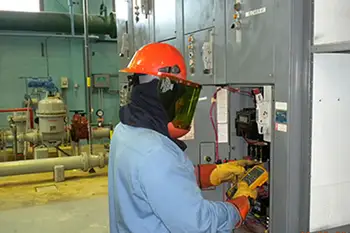Our popular Combined CSA Z462 Arc Flash Training and High Voltage Safety training course is designed for front-line workers who are responsible for electrical systems. This standard covers safe work practices related to electrical dangers in the workplace. Students will gain a solid understanding of hazards encountered while operating or maintaining electrical installations in the low voltage (below 750V) class including a full understanding of the arc hazard categorization, appropriate PPE selection and safe electrical work procedures AND the high voltage class.
High Voltage Electrical Safety Training
This 12-Hour course is designed to assist organizations to identify shock and arc flash hazards and prevent injuries and incidents associated with those hazards.
Our Combined Arc Flash/Electrical Safety Awareness Workshop is instructed by our certified electrical expert, who has more than 25 years field electrical safety and maintenance experience. This electrical safety workshop examines the hazards found in the workplace and stresses the importance of the individual employee proactively recognizing hazards and applying safe work practices with the goal of zero accidents.
CSA Z462 sets a recommended standard for Electrical Safety in Canada. It states that electrical workers "shall be trained in safety-related work practices and procedural requirements as necessary to provide protection from the electrical hazards associated with their respective jobs or task assignments. Workers shall be trained to identify and understand the relationship between electrical hazards and possible injury."
Our Electrical Safety Training Course offers:
- Electrical Safety Videos
- Physical Demonstrations Of PPE
- Group Discussion And Problem Solving Exercises
- Testing At The Conclusion Of The Course
- Job Briefing Requirements
- Hazardous Energy Control (Lockout/Tagout)
- Switching Procedures
- Clearance Procedures
- Personal Protective Equipment (PPE)
- Flame Resistant (FR) Clothing
- Rubber Protective Equipment
- Live-Line Tools & Testing Requirements
- Working On Or Near Exposed Lines
- De-Energizing Lines And Equipment
- Personal Protective Grounding
- Substation Safety
- Special Conditions
- Capacitors
- Current Transformers
- Potential Transformer Hazards
- Fuse/Relay Coordination
Students Will:
- Learn To Recognize All Medium Voltage/High Voltage Electrical Sources And Hazards Created By Various High Voltage Electrical Equipment And Devices.
- Determine The Controls Used To Protect Workers From All Energy Sources Created In The Work Place.
- Learn The Dangers Of How Induced Currents And Ground Gradients Are Produced
- Learn How To Safely Select, Install And Maintain Temporary Grounds For Protection Of The High Voltage Electrical Worker.
- Interpret and use a single line diagram to write a switching sequence to safely isolate a high voltage electrical device for work. Validate existing operating orders and switching procedures. Develop and maintain mandated documentation for all electrical equipment isolation and maintenance work.
-
Identify Electrical Safety Training Requirements For Qualified Workers
- Identify Best Practice Regulations That Address Shock And Arc Flash Hazards
- List The Steps To Perform A Shock Hazard Analysis And Describe Each Step
- Define The Shock Protection Boundaries And Describe Their Use
- List The Personal Protective Equipment Required For Shock Protection
- List The Steps To Achieve An Electrically Safe Work Condition
- Explain What An Arc Flash Is And The Injuries That Can Result
- Identify When An Arc Flash Hazard Exists
- List The Steps To Perform An Arc Flash Hazard Analysis And Describe Each Step
- Define The Term “Incident Energy,” Identify The Key Electrical System Variables That Affect It
- Define The Term “Arc Flash Protection Boundary” And Explain Its Application
- Define The Term “Arc-Rated” And Explain The Difference Between “Flame-Resistant” Clothing And “Arc Rated” Clothing
- Select Appropriate Personal Protective Equipment For Arc Flash Hazards
- Describe Methods Of Selecting Arc Flash PPE Using The New Tables. New
- List The Testing And Maintenance Requirements For Personal Protective Equipment
- Identify The Key Objectives Of Job Safety Planning


